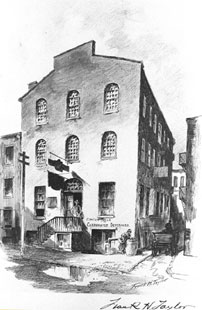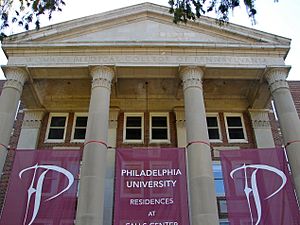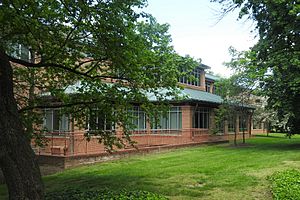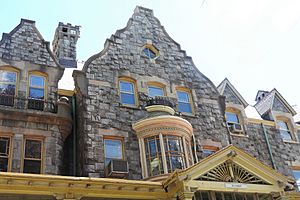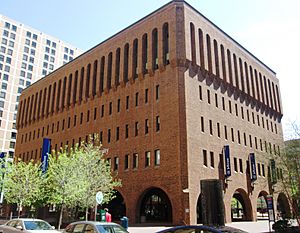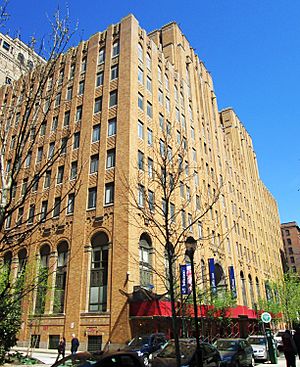Thomas Jefferson University facts for kids
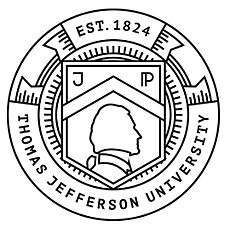 |
|
|
Former names
|
Medical Department of Jefferson College in Philadelphia (1824–1838) Jefferson Medical College (1838–1969) Philadelphia Textile School (1884–1942) Philadelphia Textile Institute (1942–1961) Philadelphia College of Textiles & Science (1961–1999) Philadelphia University (1999–2017) |
|---|---|
| Motto | "Redefining humanly possible" |
| Type | Private research university |
| Established | 1824 |
| Accreditation | MSCHE |
| Endowment | $1.533 billion (2021) |
| President | Susan C. Aldridge |
| Provost | Matt Dane Baker |
| Students | 7,831 |
| Undergraduates | 3,665 |
| Postgraduates | 4,361 |
| Location |
,
,
United States
40°1′21″N 75°11′33″W / 40.02250°N 75.19250°W |
| Campus | Large city, 104 acres (0.42 km2) |
| Colors | Deep blue and bright blue |
| Nickname | Rams |
|
Sporting affiliations
|
NCAA Division II – CACC |
| Mascot | Phil the Ram |
 |
|
Thomas Jefferson University is a private university in Philadelphia, Pennsylvania. It is a place where students and professors do a lot of research to make new discoveries. The university was formed in 2017 when two schools, Philadelphia University and Thomas Jefferson University, joined together. It is named after Thomas Jefferson, one of the Founding Fathers and a former U.S. president.
To show its history, the university sometimes uses the name Jefferson (Philadelphia University + Thomas Jefferson University) in its branding.
Contents
History of the University
Thomas Jefferson University is the result of two older schools merging. Each school had its own long and interesting history before they became one.
Philadelphia University's Story
The school that became Philadelphia University started in 1884 as the Philadelphia Textile School. At that time, Philadelphia was a major center for making textiles, which are woven fabrics. Local factory owners noticed that they were falling behind other cities in technology. They started the school to teach new skills and ideas.
The first classes were taught to just five students. But the school grew quickly. It changed its name several times as it added more programs.
- Philadelphia Textile Institute (1942–1961)
- Philadelphia College of Textiles & Science (1962–1999)
- Philadelphia University (1999–2017)
In 1949, the school moved to its current location in the East Falls neighborhood of Philadelphia. Over the years, it bought more land and buildings, adding classrooms, labs, and dorms for students. In 1999, it officially became a university because it offered so many different fields of study.
Thomas Jefferson University's Story
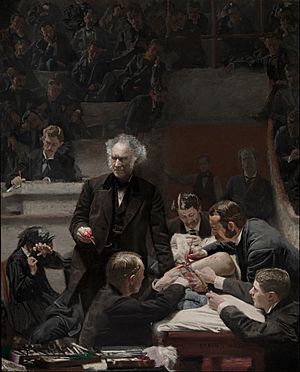
The other half of the university began as a medical school in 1824. At the time, it was hard to start a new medical school in Philadelphia because the University of Pennsylvania's medical school was already very powerful.
A group of doctors led by Dr. George McClellan found a clever way to open their school. They asked Jefferson College (now Washington & Jefferson College), located in another part of Pennsylvania, to create a medical department in Philadelphia. The college agreed, and the Medical Department of Jefferson College in Philadelphia was born.
The first classes were held in a theater. The school focused on hands-on practice, which was a new idea. In 1838, the medical school became its own separate college, called Jefferson Medical College. It opened one of the first hospitals in the country to be connected with a medical school. In 1969, it became Thomas Jefferson University.
A Famous Painting
In 2007, the university sold a famous painting called The Gross Clinic by Thomas Eakins. The painting shows a real surgery that happened at the school. It was sold for $68 million to two museums in Philadelphia. Today, a copy of the painting hangs at the university.
The Big Merger
In 2017, Philadelphia University and Thomas Jefferson University officially merged. They combined their strengths in design, science, and medicine to become the university that exists today.
What Can You Study at Jefferson?
Jefferson offers over 160 programs for both undergraduate and graduate students. Students can earn degrees in many different subjects. Some of the main colleges within the university include:
- Sidney Kimmel Medical College
- College of Architecture and the Built Environment
- Kanbar College of Design, Engineering and Commerce
- School of Continuing and Professional Studies
Campus Life
The university has two main campuses in Philadelphia and a research center.
East Falls Campus
The East Falls campus is a large, wooded area with 52 buildings. It has classrooms, labs, art studios, a library, and places for students to live. It feels like a traditional college campus but is just a short train ride from the city center.
Center City Campus
The Center City campus is in the heart of downtown Philadelphia. This is where the university's medical school, hospital, and main offices are located. It is a busy, urban environment surrounded by the city's attractions.
Manayunk Research Center
Jefferson also has a research center in a restored old factory building. Here, students and professors work on projects related to engineering, design, and safety.
Sports at Jefferson
Jefferson's sports teams are called the Rams. They compete in NCAA Division II sports. This means they play against other medium-sized colleges. Their main conference is the Central Atlantic Collegiate Conference (CACC).
The university has 17 sports teams, including:
- Men's sports: baseball, basketball, soccer, and tennis.
- Women's sports: basketball, lacrosse, soccer, softball, and volleyball.
When the two universities merged, they decided to keep the Rams nickname from Philadelphia University.
Famous Graduates
Many successful people have graduated from the university over the years. Here are a few of them:
- James P. Bagian - A doctor, engineer, and former NASA astronaut.
- Carlos Finlay - A doctor who discovered that mosquitoes spread yellow fever.
- John Heysham Gibbon - The inventor of the heart-lung machine, which is used in major surgeries.
- Robert Gallo - A scientist who helped discover the virus that causes AIDS.
- Maurice Kanbar - An inventor and philanthropist who created many products.
- Herb Magee - A famous college basketball coach who coached at the university for many years.
- Silas Weir Mitchell - Known as the "father of medical neurology," the study of the nervous system.
- Jay McCarroll - The first winner of the fashion design TV show Project Runway.
See also
 In Spanish: Universidad de Filadelfia para niños
In Spanish: Universidad de Filadelfia para niños


